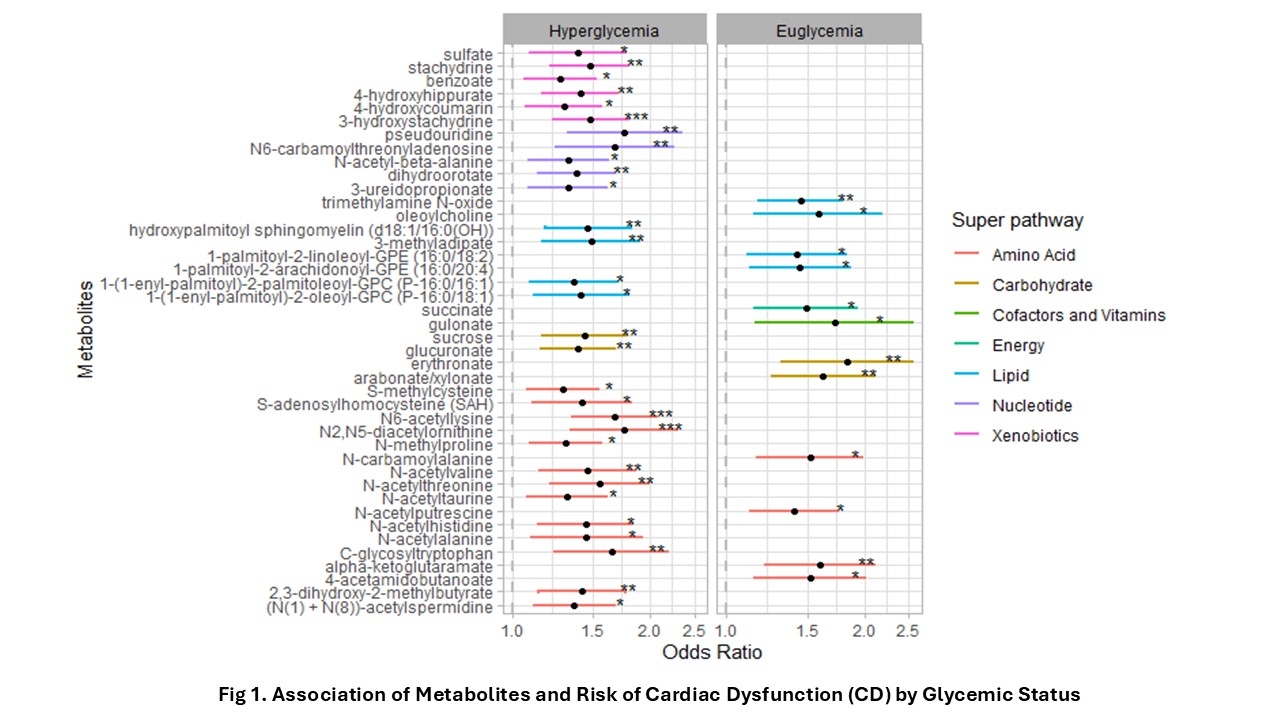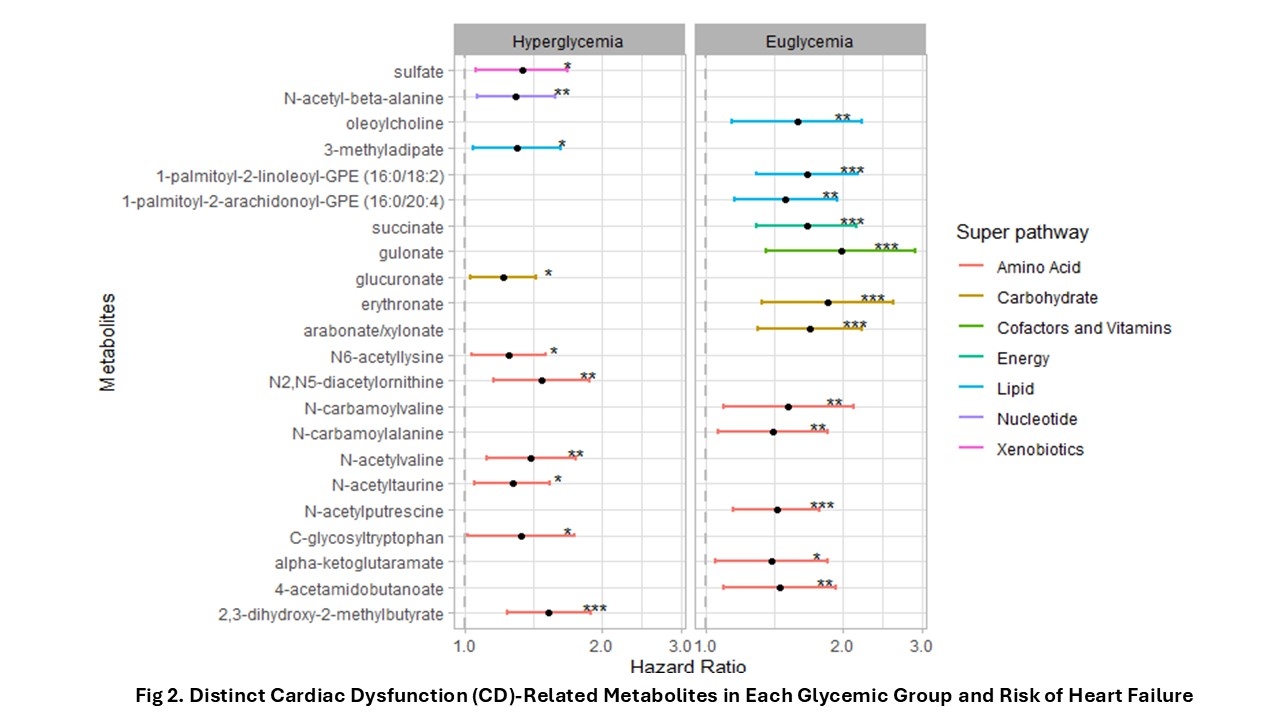Final ID: P3056
A Metabolomic Study of Cardiac Dysfunction in Hyperglycemia
Abstract Body: Objective: Hyperglycemia (pre-diabetes and diabetes, DM) is associated with heart failure (HF). We aimed to identify distinct metabolites for subclinical cardiac dysfunction (CD), a precursor of HF, in hyperglycemic vs. euglycemic groups.
Method: We used data from the ARIC study (Atherosclerosis Risk in Communities). In HF-free 2492 participants at baseline (2011-2013), 1297 were hyperglycemic (HbA1c>5.7%, fasting glucose>100 mg/dL, DM medication, or a DM diagnosis) and 1195 were euglycemic. We performed logistic regression for the association of 790 metabolites and CD, defined by echocardiographic abnormalities (LV hypertrophy, systolic or diastolic dysfunction) or elevated biomarkers (NTproBNP>125 pg/mL or HS troponin T>14 ng/L in women, >22 ng/L in men) at baseline in two glycemic groups separately. We used Cox regression to evaluate the association between CD-related metabolites (i.e., significant metabolites in the cross-sectional analyses) with HF risk. Analyses were adjusted for clinical risk factors and multiple comparisons (FDR< 5%) and replicated in the Hispanic Community Health Study/Study of Latinos (HCHS/SOL).
Results: 34 out of 790 and 16 out of 790 metabolites were associated with CD in the hyperglycemic (15% Black, 33% men) and euglycemic (22% Black, 47% men) groups, respectively. Metabolites previously identified as microvascular disease-related markers (e.g., pseudouridine, N6-carbamoylthreonyladenosine, N6-acetyllysine, N2, N5-diacetylornithine) were associated with CD in the hyperglycemic group (Fig1). Carbohydrate and cofactor-derived metabolites (e.g., gulonate, erythrocyte) were associated with CD in the euglycemic group (Fig1). 10 and 12 distinct CD-related metabolites in hyperglycemic and euglycemic groups, respectively, were also prospectively associated with HF risk (Hazard Ratios 1.2-1.9)(Fig2). 24 out of 34 and 11 out of 16 CD-related metabolites in the hyperglycemic and euglycemic groups, respectively, were available for validation in HCHS/SOL (n 1202, 34% men). The results were consistent with ARIC, where 10 and 12 distinct CD-related metabolites showed nominal significant association with incident HF in two glycemic groups, respectively.
Conclusion: Metabolites known for microvascular complications (retinopathy, kidney disease) were associated with CD among hyperglycemic participants, supporting the premise that microvascular dysfunction contributes to HF pathogenesis in people with hyperglycemia.
Method: We used data from the ARIC study (Atherosclerosis Risk in Communities). In HF-free 2492 participants at baseline (2011-2013), 1297 were hyperglycemic (HbA1c>5.7%, fasting glucose>100 mg/dL, DM medication, or a DM diagnosis) and 1195 were euglycemic. We performed logistic regression for the association of 790 metabolites and CD, defined by echocardiographic abnormalities (LV hypertrophy, systolic or diastolic dysfunction) or elevated biomarkers (NTproBNP>125 pg/mL or HS troponin T>14 ng/L in women, >22 ng/L in men) at baseline in two glycemic groups separately. We used Cox regression to evaluate the association between CD-related metabolites (i.e., significant metabolites in the cross-sectional analyses) with HF risk. Analyses were adjusted for clinical risk factors and multiple comparisons (FDR< 5%) and replicated in the Hispanic Community Health Study/Study of Latinos (HCHS/SOL).
Results: 34 out of 790 and 16 out of 790 metabolites were associated with CD in the hyperglycemic (15% Black, 33% men) and euglycemic (22% Black, 47% men) groups, respectively. Metabolites previously identified as microvascular disease-related markers (e.g., pseudouridine, N6-carbamoylthreonyladenosine, N6-acetyllysine, N2, N5-diacetylornithine) were associated with CD in the hyperglycemic group (Fig1). Carbohydrate and cofactor-derived metabolites (e.g., gulonate, erythrocyte) were associated with CD in the euglycemic group (Fig1). 10 and 12 distinct CD-related metabolites in hyperglycemic and euglycemic groups, respectively, were also prospectively associated with HF risk (Hazard Ratios 1.2-1.9)(Fig2). 24 out of 34 and 11 out of 16 CD-related metabolites in the hyperglycemic and euglycemic groups, respectively, were available for validation in HCHS/SOL (n 1202, 34% men). The results were consistent with ARIC, where 10 and 12 distinct CD-related metabolites showed nominal significant association with incident HF in two glycemic groups, respectively.
Conclusion: Metabolites known for microvascular complications (retinopathy, kidney disease) were associated with CD among hyperglycemic participants, supporting the premise that microvascular dysfunction contributes to HF pathogenesis in people with hyperglycemia.
More abstracts on this topic:
A phenomapping-informed machine learning tool estimates individualized cardiometabolic effects from Tirzepatide and generalizes to a new population.
Thangaraj Phyllis, Oikonomou Evangelos, Khera Rohan
Cardiac Branched-Chain Amino Acid Metabolic Dysfunction in a Novel Model of Diabetic CardiomyopathyNagao Manabu, Asakura Junko, Hosooka Tetsuya, Kuwahara Naoya, Kaneshiro Kenta, Tanaka Hidekazu, Ishida Tatsuro, Otake Hiromasa, Shinohara Masakazu


